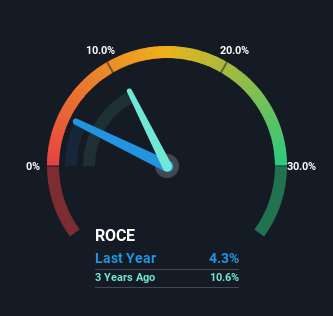
If we want to find a stock that could multiply over the long term, what are the underlying trends we should look for? Firstly, we'll want to see a proven return on capital employed (ROCE) that is increasing, and secondly, an expanding base of capital employed. This shows us that it's a compounding machine, able to continually reinvest its earnings back into the business and generate higher returns. So when we looked at COSCO SHIPPING Development (HKG:2866) and its trend of ROCE, we really liked what we saw.
Return On Capital Employed (ROCE): What Is It?
Just to clarify if you're unsure, ROCE is a metric for evaluating how much pre-tax income (in percentage terms) a company earns on the capital invested in its business. To calculate this metric for COSCO SHIPPING Development, this is the formula:
Return on Capital Employed = Earnings Before Interest and Tax (EBIT) ÷ (Total Assets - Current Liabilities)
0.043 = CN¥4.0b ÷ (CN¥123b - CN¥30b) (Based on the trailing twelve months to September 2024).
So, COSCO SHIPPING Development has an ROCE of 4.3%. In absolute terms, that's a low return and it also under-performs the Trade Distributors industry average of 5.6%.
Check out our latest analysis for COSCO SHIPPING Development

Historical performance is a great place to start when researching a stock so above you can see the gauge for COSCO SHIPPING Development's ROCE against it's prior returns. If you'd like to look at how COSCO SHIPPING Development has performed in the past in other metrics, you can view this free graph of COSCO SHIPPING Development's past earnings, revenue and cash flow.
So How Is COSCO SHIPPING Development's ROCE Trending?
Even though ROCE is still low in absolute terms, it's good to see it's heading in the right direction. More specifically, while the company has kept capital employed relatively flat over the last five years, the ROCE has climbed 43% in that same time. Basically the business is generating higher returns from the same amount of capital and that is proof that there are improvements in the company's efficiencies. On that front, things are looking good so it's worth exploring what management has said about growth plans going forward.
One more thing to note, COSCO SHIPPING Development has decreased current liabilities to 24% of total assets over this period, which effectively reduces the amount of funding from suppliers or short-term creditors. So shareholders would be pleased that the growth in returns has mostly come from underlying business performance.
In Conclusion...
To sum it up, COSCO SHIPPING Development is collecting higher returns from the same amount of capital, and that's impressive. Since the stock has returned a solid 96% to shareholders over the last five years, it's fair to say investors are beginning to recognize these changes. So given the stock has proven it has promising trends, it's worth researching the company further to see if these trends are likely to persist.
On a final note, we found 3 warning signs for COSCO SHIPPING Development (2 can't be ignored) you should be aware of.
If you want to search for solid companies with great earnings, check out this free list of companies with good balance sheets and impressive returns on equity.
Have feedback on this article? Concerned about the content? Get in touch with us directly. Alternatively, email editorial-team (at) simplywallst.com.
This article by Simply Wall St is general in nature. We provide commentary based on historical data and analyst forecasts only using an unbiased methodology and our articles are not intended to be financial advice. It does not constitute a recommendation to buy or sell any stock, and does not take account of your objectives, or your financial situation. We aim to bring you long-term focused analysis driven by fundamental data. Note that our analysis may not factor in the latest price-sensitive company announcements or qualitative material. Simply Wall St has no position in any stocks mentioned.